Our question
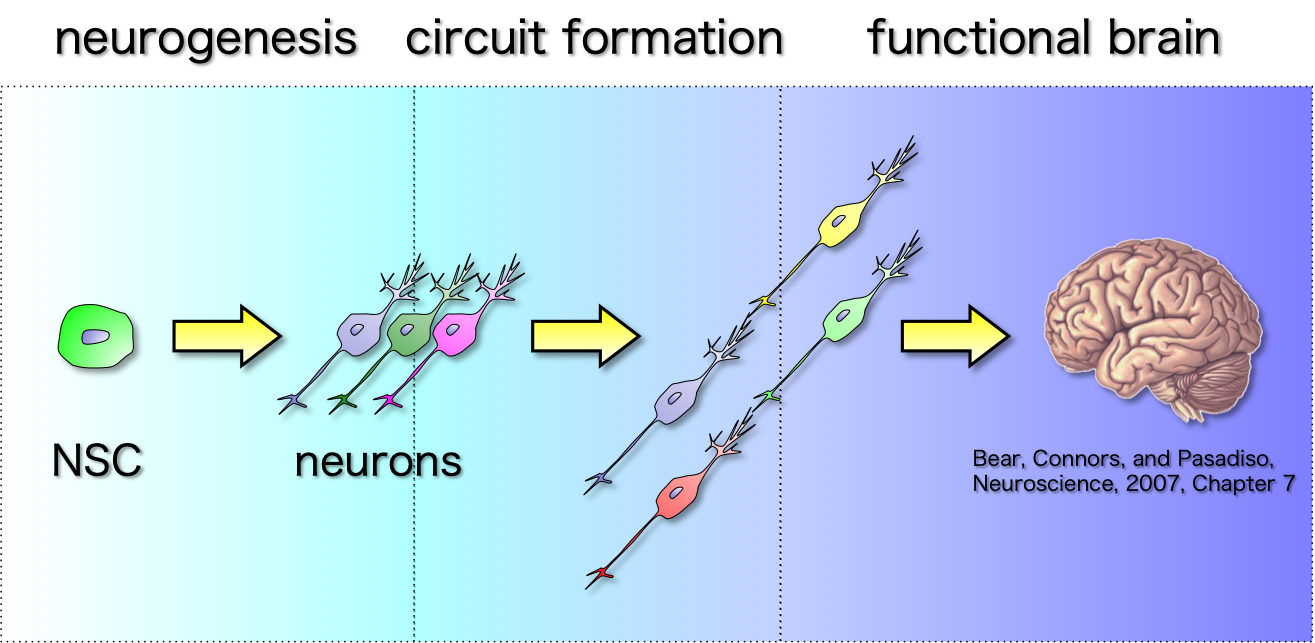
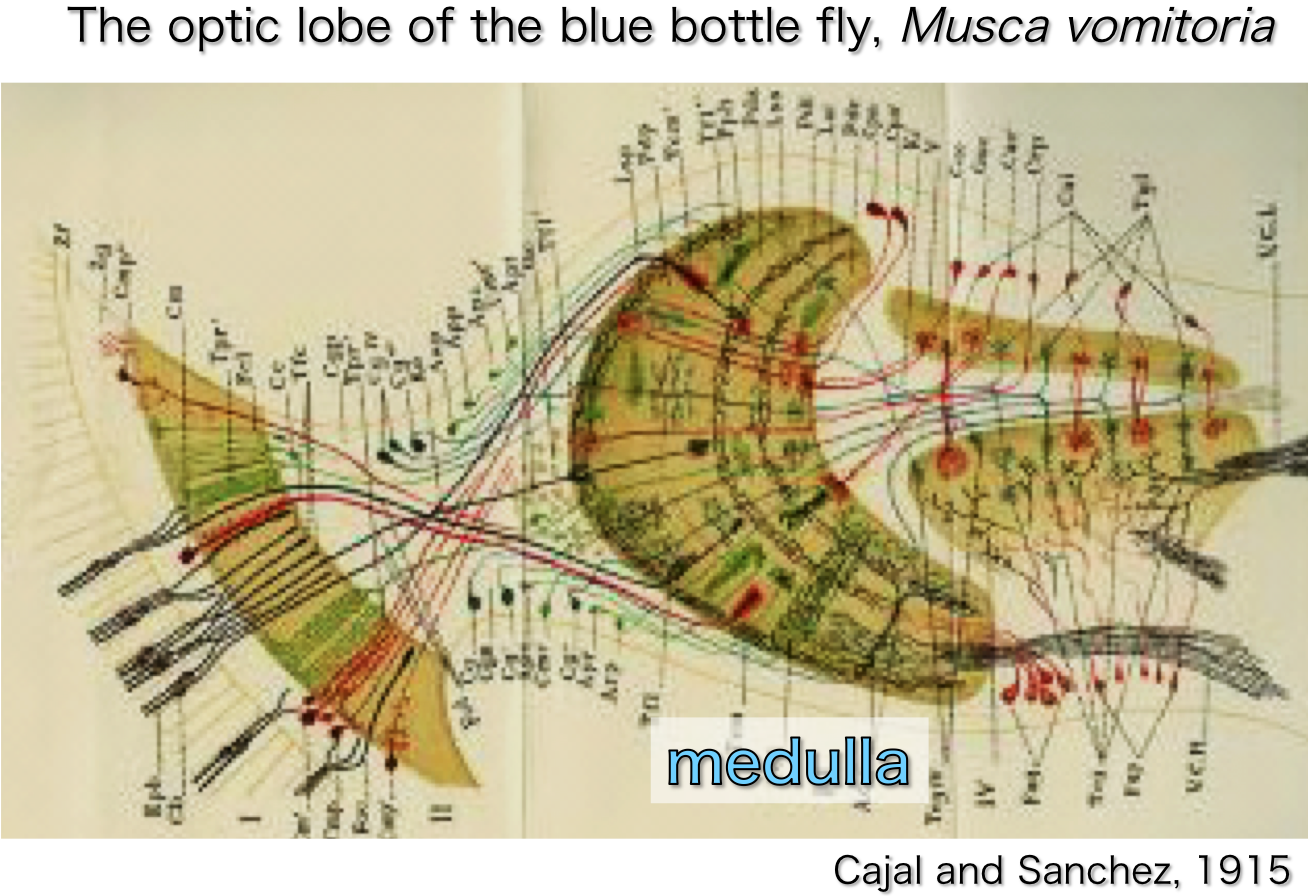 The brain consists of a huge number of neurons, and they connect to their own partners to form highly complex neural circuits. Neural circuits process information perceived by sensory organs such as the eyes, nose, and ears to let us recognize what we see, smell, and hear. Thus, the formation of precise neural circuits is essential for brain functions. These neurons are produced from neural stem cells (NSCs), and they construct complex neural circuits during development.
The brain consists of a huge number of neurons, and they connect to their own partners to form highly complex neural circuits. Neural circuits process information perceived by sensory organs such as the eyes, nose, and ears to let us recognize what we see, smell, and hear. Thus, the formation of precise neural circuits is essential for brain functions. These neurons are produced from neural stem cells (NSCs), and they construct complex neural circuits during development.When and how does the brain acquire its complex functions?
To answer this question, it is important to understand the molecular mechanisms that regulate the production of neurons and the formation of the neural circuit.
In our laboratory, we focus on the visual center of the Drosophila fruit fly as a model system to study the regulatory mechanisms of brain development. The fly visual center is composed of four different ganglia: the retina, lamina, medulla, and lobula complex. Among them, the medulla, which is the largest component, shares structural features with the mammalian brain, such as laminar and columnar structures. The medulla contains 100 types of 40,000 neurons and is tractable compared with the mammalian cerebral cortex. Moreover, the Drosophila life cycle is short, and fly genetics is a powerfull tool for the examination of developmental mechanisms.
Topic1, How do neuroepithelial cells differentiate into neural stem cells at right time?
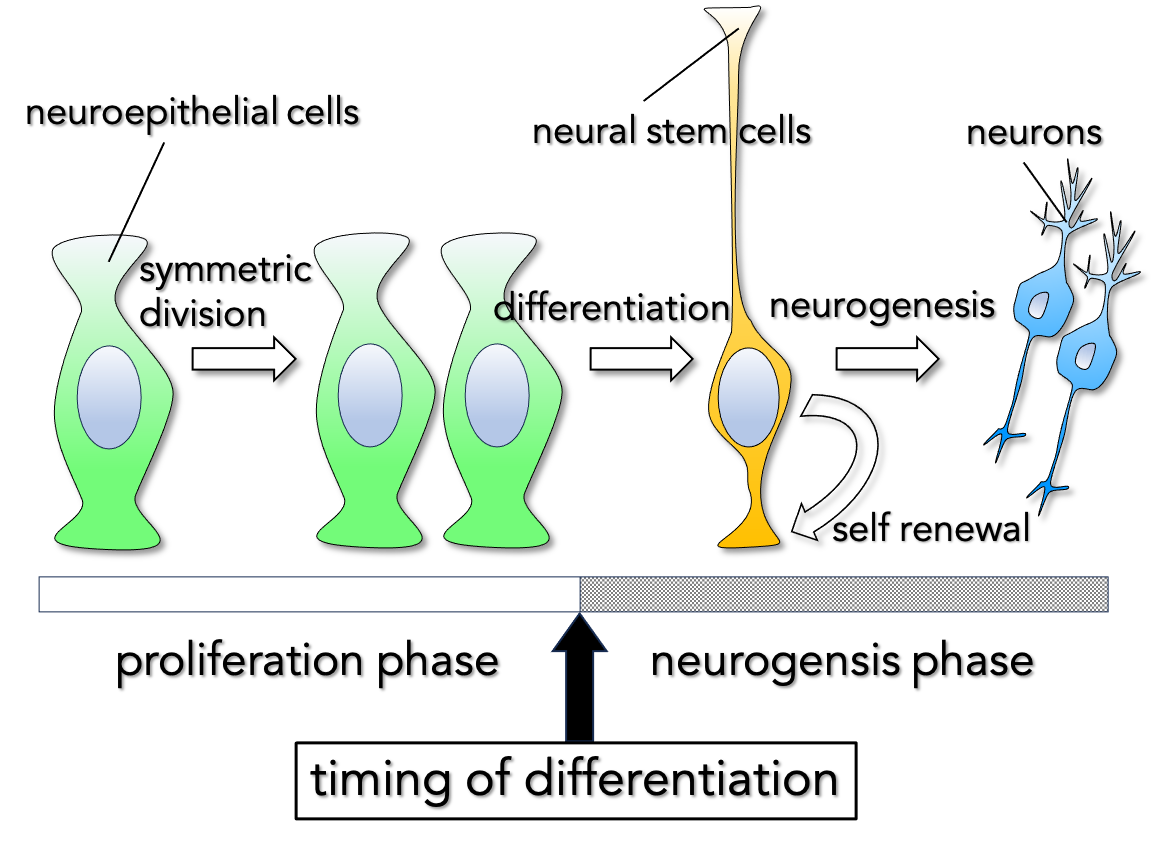 During brain development, neural stem cells produce a large number of a wide variety of neurons, and the neurons establish complex neuronal circuits to make the brain function correctly. For sufficient amounts of neurons to construct a functional brain, sufficient amounts of neural stem cells must be born because the number of neural stem cells reflects the total number of neurons in the brain. Neural stem cells arise from neuroepithelial cells. Before these neural stem cells emerge, the neuroepithelial cell population must be expanded to secure the necessary amount of neural stem cells for successful brain development. Although the timing of the transition from the proliferative to neurogenic phase must be strictly determined, the whole picture of the molecular mechanisms that regulate the phase transition in neuroepithelial cells is still unclear.
During brain development, neural stem cells produce a large number of a wide variety of neurons, and the neurons establish complex neuronal circuits to make the brain function correctly. For sufficient amounts of neurons to construct a functional brain, sufficient amounts of neural stem cells must be born because the number of neural stem cells reflects the total number of neurons in the brain. Neural stem cells arise from neuroepithelial cells. Before these neural stem cells emerge, the neuroepithelial cell population must be expanded to secure the necessary amount of neural stem cells for successful brain development. Although the timing of the transition from the proliferative to neurogenic phase must be strictly determined, the whole picture of the molecular mechanisms that regulate the phase transition in neuroepithelial cells is still unclear.In the medulla primordium, the differentiation from neuroepithelial to neural stem cells occurs in waves from the medial edge of the medulla primordium to the lamina precursor, and it progresses in a single cell row width, which is called the proneural wave (Yasugi et al., 2008). We focus on the regulatory mechanisms that regulate the wave progress.
Topic2, How is neuronal diversity generated?
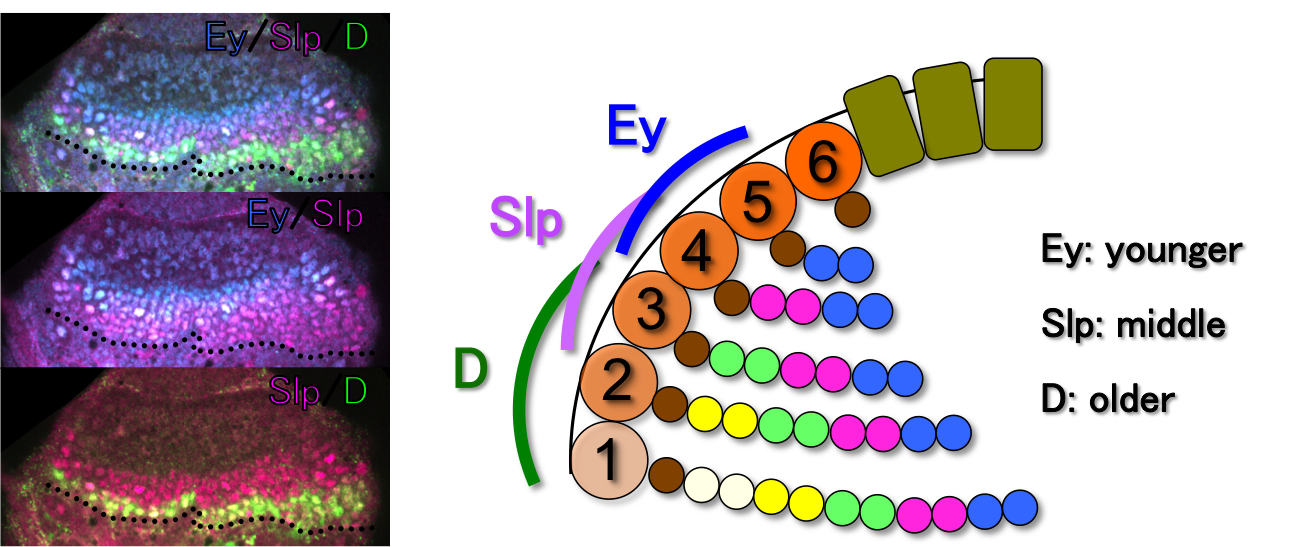
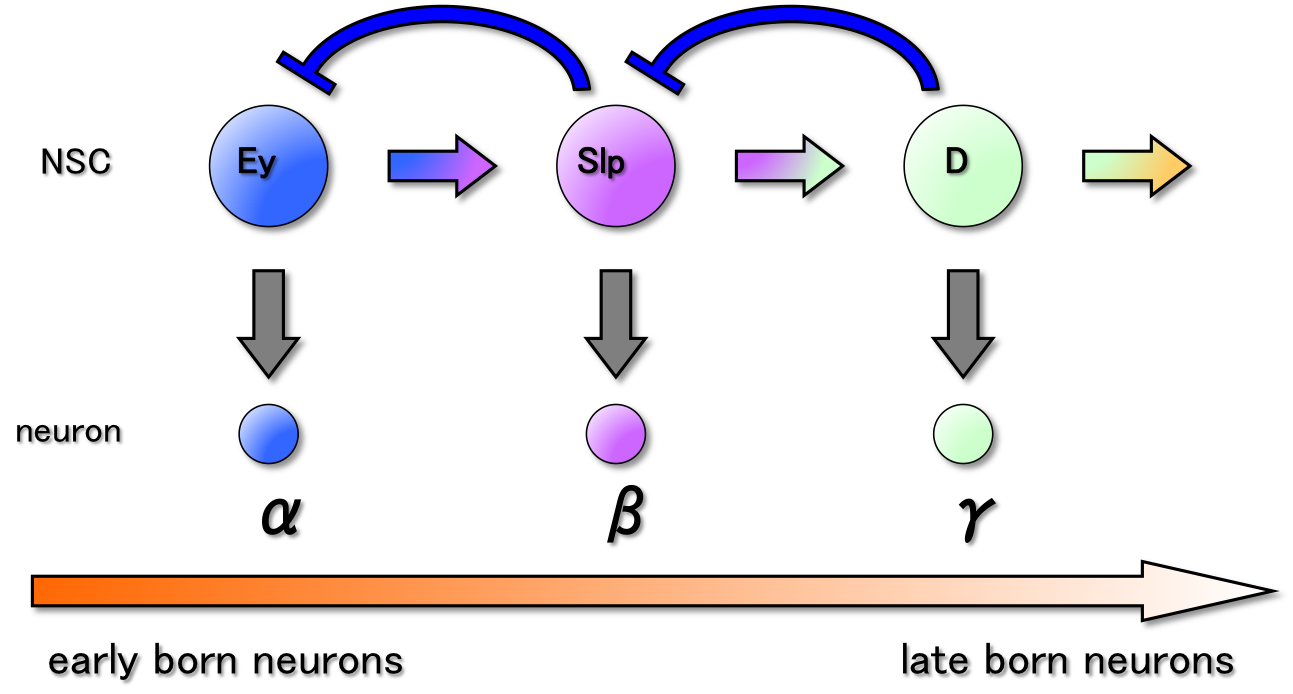 The brain contains a wide variety of neurons, from small to large and from simple to highly complex neurons. All of these neurons are generated from NSCs, but we do not know how NSCs produce these various neurons.
The brain contains a wide variety of neurons, from small to large and from simple to highly complex neurons. All of these neurons are generated from NSCs, but we do not know how NSCs produce these various neurons.We reported that transcription factors that are transiently expressed in NSCs (called temporal factors) play important roles in the generation of neuronal diversity (Suzuki et al., 2013; 2016). We identified several transcription factors that are transiently expressed in NSCs of the medulla primordium. Eyeless (Ey), Sloppy-paired (Slp), and Dichaete (D) are expressed in the younger, middle, and older NSCs, respectively. We conducted a functional analysis of these transcription factors and found that they regulate neuronal fate determination. Thus, this sequential change in transcription factors expressed in NSCs causes the production of various neurons.
As a next step in this research, we will try to reveal the underlying mechanisms regulated by each temporal factor.
Topic3, How is a precise neural circuit formed?
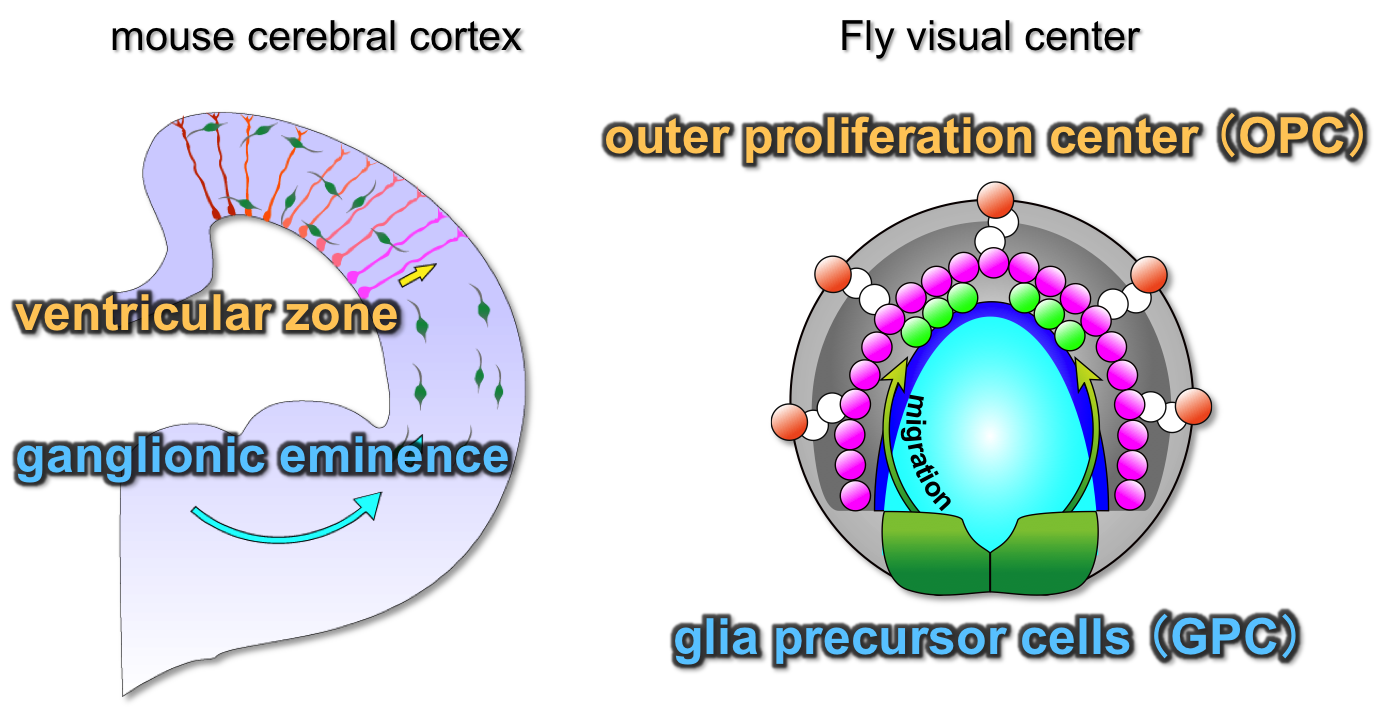 To form a precise neural circuit, neurons have to locate at an ideal position to recognize and connect to their partners. This precise neural circuit is essential for brain functions. However, we do not know the molecular mechanisms that regulate the formation of neural circuits.
To form a precise neural circuit, neurons have to locate at an ideal position to recognize and connect to their partners. This precise neural circuit is essential for brain functions. However, we do not know the molecular mechanisms that regulate the formation of neural circuits.In the mammalian cerebral cortex, there are two different sources of neurons: the ventricular zone and the ganglionic eminence. The neurons derived from the ganglionic eminence migrate tangentially toward the developing cerebral cortex to connect neurons derived from the ventricular zone, resulting in the formation of a complex neural circuit. We reported that the medulla also consists of neurons derived from two different sources: the outer proliferation center (OPC) and glial precursor cells (GPCs). (Suzuki et al., 2016). The neurons derived from GPCs also migrate tangentially to reach the medulla.
We focus on the OPC- and GPC-derived neurons that are involved in the same processing pathway to study regulatory mechanisms of neuronal migration and partner recognition.

